Optimization and Modelling of the Physical and Mechanical Properties of Grass Fiber Reinforced with Slag-Based Composites Using Response Surface Methodology
Abstract
:1. Introduction
2. Experiments and Methods
2.1. Materials and Sample Preparation
2.1.1. Materials
- Grass
- Slag
- Quicklime
- Fine aggregate
- Additives
- Water
2.1.2. Sample Preparation
2.2. Performance Test Experiments
2.2.1. Microstructural Observations
- X-ray diffractometer
- Scanning Electron Microscope (SEM)
2.2.2. Physical Property Tests
- Apparent density
- Apparent porosity
- Water absorption
2.2.3. Mechanical Property Tests
- Flexural strength
2.3. Response Surface Method (RSM)
3. Results and Discussion
3.1. Single-Factor Experimental
3.1.1. Effect of Grass Size, Grass Content, and Quicklime Content on Compressive Strength
3.1.2. Effect of Grass Size, Grass Content, and Quicklime Content on Flexural Strength
3.1.3. Effect of Grass Size, Grass Content, and Quicklime Content on Water Absorption Strength
3.2. RSM Experiment
3.2.1. Design of Experiment (DoE)
3.2.2. Model Building and Testing
Yβ = 2.08 + 0.24 × A − 0.11 × B + 0.16 × C − 0.2 × AB − 0.028 × AC − 0.12 × BC − 0.46 × A2 − 0.68 × B2 − 0.71 × C2
Yγ = 22.02 − 0.54 × A + 2.5 × B + 2.85 × C − 0.29 × AB + 0.72 × AC − 1.1 × BC + 2.89 × A2 + 1.77 × B2 + 4.4 × C2
3.2.3. Multi-Factor Experimental Results
3.2.4. Optimization and Validation
3.3. Analysis of Microscopic Performance
3.3.1. X-ray Diffraction
3.3.2. Micromorphology
4. Conclusions
- The effects of grass size, grass content, and quicklime content on compressive strength, flexural strength, and water absorption rate were studied through single-factor experiments. Based on these results, the influencing factors and levels for the response surface experiments were determined: the range of grass size is 1–3 mm, the range of grass content is 5–15 g, and the range of quicklime content is 27.5–47.5 g.
- A second-order polynomial regression equation was used to fit the experimental data, establishing a response surface model to describe the relationship between the three factors and the three response variables. RSM predicts that when the grass size, grass content, and quicklime content are 2.0 mm, 8.2 g, and 38 g, respectively, the compressive strength and flexural strength reach their maximum values. In contrast, the water absorption rate reaches its minimum, precisely 12.1 MPa, 2.18 MPa, and 21.52%. The optimized experimental values were 11.425 MPa, 2.145 MPa, and 21.89%, respectively. The experimental and predicted values differ by only 8%, indicating a good fit.
- The use of microstructural properties provides valuable insights into the characterization of materials. XRD analysis indicated that the primary component of alfalfa fiber is cellulose, which is hydrophilic and increases the water absorption rate of the composite material. This leads to the degradation of cellulose and results in poor stress transfer efficiency, subsequently decreasing the mechanical properties of the composite material. SEM experiments were conducted on well-performing specimens to analyze the internal structural characteristics of the composite material. The results showed that the grass material was not easily detected under microscopic observation, likely due to the better uniformity of the fiber material within the composite, which reduces pore volume. Additionally, the rough surface of the grass fibers facilitates better bonding with the matrix material, enhancing the density and strength of the composite.
Author Contributions
Funding
Institutional Review Board Statement
Informed Consent Statement
Data Availability Statement
Conflicts of Interest
References
- Damtoft, J.S.; Lukasik, J.; Herfort, D.; Sorrentino, D.; Gartner, E.M. Sustainable development and climate change initiatives. Cem. Concr. Res. 2008, 38, 115–127. [Google Scholar] [CrossRef]
- Malhotra, V.J. Introduction: Sustainable development and concrete technology. Concr. Int. 2002, 24, 22. [Google Scholar]
- Pacheco-Torgal, F.; Castro-Gomes, J.; Jalali, S. Alkali-activated binders: A review. Part 2. About materials and binders manufacture. Constr. Build. Mater. 2008, 22, 1315–1322. [Google Scholar] [CrossRef]
- Palomo, A.; Grutzeck, M.; Blanco, M.J.C. Alkali-activated fly ashes: A cement for the future. Cem. Concr. Res. 1999, 29, 1323–1329. [Google Scholar] [CrossRef]
- Wang, S.-D.; Pu, X.-C.; Scrivener, K.; Pratt, P.J. Alkali-activated slag cement and concrete: A review of properties and problems. Cem. Concr. Res. 1995, 7, 93–102. [Google Scholar] [CrossRef]
- Collins, F.; Sanjayan, J.G. Workability and mechanical properties of alkali activated slag concrete. Cem. Concr. Res. 1999, 29, 455–458. [Google Scholar] [CrossRef]
- Yang, K.-H.; Song, J.-K.; Ashour, A.F.; Lee, E.-T. Properties of cementless mortars activated by sodium silicate. Constr. Build. Mater. 2008, 22, 1981–1989. [Google Scholar] [CrossRef]
- Oh, J.E.; Monteiro, P.J.; Jun, S.S.; Choi, S.; Clark, S.M. The evolution of strength and crystalline phases for alkali-activated ground blast furnace slag and fly ash-based geopolymers. Cem. Concr. Res. 2010, 40, 189–196. [Google Scholar] [CrossRef]
- Choi, J.-I.; Song, K.-I.; Song, J.-K.; Lee, B.Y. Composite properties of high-strength polyethylene fiber-reinforced cement and cementless composites. Constr. Build. Mater. 2016, 138, 116–121. [Google Scholar] [CrossRef]
- Lee, B.Y.; Cho, C.-G.; Lim, H.-J.; Song, J.-K.; Yang, K.-H.; Li, V.C. Strain hardening fiber reinforced alkali-activated mortar—A feasibility study. Cem. Concr. Compos. 2012, 37, 15–20. [Google Scholar] [CrossRef]
- Choi, J.-I.; Lee, B.Y.; Ranade, R.; Li, V.C.; Lee, Y. Ultra-high-ductile behavior of a polyethylene fiber-reinforced alkali-activated slag-based composite. Cem. Concr. Res. 2016, 70, 153–158. [Google Scholar] [CrossRef]
- Dias, D.P.; Thaumaturgo, C. Fracture toughness of geopolymeric concretes reinforced with basalt fibers. Cem. Concr. Compos. 2005, 27, 49–54. [Google Scholar] [CrossRef]
- Savastano, H., Jr.; Warden, P.G.; Coutts, R.S. Potential of alternative fibre cements as building materials for developing areas. Cem. Concr. Compos. 2003, 25, 585–592. [Google Scholar] [CrossRef]
- Nehdi, M.; Khan, A. Cementitious composites containing recycled tire rubber: An overview of engineering properties and potential applications. Cem. Concr. Compos. 2001, 23, 3–10. [Google Scholar] [CrossRef]
- Li, G.; Garrick, G.; Eggers, J.; Abadie, C.; Stubblefield, M.A.; Pang, S.-S. Waste tire fiber modified concrete. Compos. Part B. 2004, 35, 305–312. [Google Scholar] [CrossRef]
- Eldin, N.N.; Senouci, A.B. Measurement and prediction of the strength of rubberized concrete. Cem. Concr. Compos. 1994, 16, 287–298. [Google Scholar] [CrossRef]
- Poletanovic, B.; Dragas, J.; Ignjatovic, I.; Komljenovic, M.; Merta, I. Physical and mechanical properties of hemp fibre reinforced alkali-activated fly ash and fly ash/slag mortars. Constr. Build. Mater. 2020, 259, 119677. [Google Scholar] [CrossRef]
- Liu, Z.; Tisserat, B.H. Coating applications to natural fiber composites to improve their physical, surface and water absorption characters. Ind. Crops Prod. 2018, 112, 196–199. [Google Scholar] [CrossRef]
- Zhao, J.; Yao, Y.; Cui, Q.; Wang, X.-M. Optimization of processing variables and mechanical properties in rubber-wood particles reinforced cement based composites manufacturing technology. Constr. Build. Mater. 2013, 50, 193–201. [Google Scholar] [CrossRef]
- Coutts, R.S. A review of Australian research into natural fibre cement composites. Cem. Concr. Compos. 2005, 27, 518–526. [Google Scholar] [CrossRef]
- Toledo Filho, R.D.; Ghavami, K.; Sanjuán, M.A.; England, G.L. Free, restrained and drying shrinkage of cement mortar composites reinforced with vegetable fibres. Cem. Concr. Compos. 2005, 27, 537–546. [Google Scholar] [CrossRef]
- Tolêdo Filho, R.D.; Scrivener, K.; England, G.L.; Ghavami, K. Durability of alkali-sensitive sisal and coconut fibres in cement mortar composites. Cem. Concr. Compos. 2000, 22, 127–143. [Google Scholar] [CrossRef]
- de Almeida Melo Filho, J.; de Andrade Silva, F.; Toledo Filho, R.D. Degradation kinetics and aging mechanisms on sisal fiber cement composite systems. Cem. Concr. Compos. 2013, 40, 30–39. [Google Scholar] [CrossRef]
- Silva, F.d.A.; Filho, R.D.T.; Filho, J.d.A.M.; Fairbairn, E.d.M.R. Physical and mechanical properties of durable sisal fiber–cement composites. Constr. Build. Mater. 2010, 24, 777–785. [Google Scholar] [CrossRef]
- Jarabo, R.; Fuente, E.; Monte, M.; Savastano, H., Jr.; Mutjé, P.; Negro, C. Use of cellulose fibers from hemp core in fiber-cement production. Effect on flocculation, retention, drainage and product properties. Ind. Crops Prod. 2012, 39, 89–96. [Google Scholar] [CrossRef]
- Sedan, D.; Pagnoux, C.; Smith, A.; Chotard, T. Mechanical properties of hemp fibre reinforced cement: Influence of the fibre/matrix interaction. Cem. Concr. Compos. 2008, 28, 183–192. [Google Scholar] [CrossRef]
- Andiç-Çakir, Ö.; Sarikanat, M.; Tüfekçi, H.B.; Demirci, C.; Erdoğan, Ü.H. Physical and mechanical properties of randomly oriented coir fiber–cementitious composites. Compos. Part B 2014, 61, 49–54. [Google Scholar] [CrossRef]
- Asasutjarit, C.; Charoenvai, S.; Hirunlabh, J.; Khedari, J. Materials and mechanical properties of pretreated coir-based green composites. Compos. Part B 2009, 40, 633–637. [Google Scholar] [CrossRef]
- Li, Z.; Wang, L.; Wang, X. Flexural characteristics of coir fiber reinforced cementitious composites. Cem. Concr. Compos. 2006, 7, 286–294. [Google Scholar] [CrossRef]
- Ardanuy, M.; Claramunt, J.; García-Hortal, J.A.; Barra, M. Fiber-matrix interactions in cement mortar composites reinforced with cellulosic fibers. Cem. Concr. Compos. 2011, 18, 281–289. [Google Scholar] [CrossRef]
- Petrella, A.; Spasiano, D.; Liuzzi, S.; Ayr, U.; Cosma, P.; Rizzi, V.; Petrella, M.; Di Mundo, R. Use of cellulose fibers from wheat straw for sustainable cement mortars. J. Sustain. Cem. Based Mater. 2019, 8, 161–179. [Google Scholar] [CrossRef]
- Pachla, E.C.; Silva, D.B.; Stein, K.J.; Marangon, E.; Chong, W. Sustainable application of rice husk and rice straw in cellular concrete composites. Constr. Build. Mater. 2021, 283, 122770. [Google Scholar] [CrossRef]
- Millogo, Y.; Morel, J.-C.; Aubert, J.-E.; Ghavami, K. Experimental analysis of Pressed Adobe Blocks reinforced with Hibiscus cannabinus fibers. Constr. Build. Mater. 2014, 52, 71–78. [Google Scholar] [CrossRef]
- Li, Z.; Wang, L.; Wang, X. Compressive and flexural properties of hemp fiber reinforced concrete. Fibers Polym. 2004, 5, 187–197. [Google Scholar] [CrossRef]
- Reis, J.M.L. Fracture and flexural characterization of natural fiber-reinforced polymer concrete. Constr. Build. Mater. 2006, 20, 673–678. [Google Scholar] [CrossRef]
- Chin, S.C.; Shaaban, I.G.; Rizzuto, J.P.; Khan, S.U.; Mohamed, D.; Roslan, N.I.M.; Aziz, A.A. Predictive models for mechanical properties of hybrid fibres reinforced concrete containing bamboo and basalt fibres. Structures 2024, 61, 106093. [Google Scholar] [CrossRef]
- Feng, B.; Liu, J.; Lu, Z.; Zhang, M.; Tan, X. Study on properties and durability of alkali activated rice straw fibers cement composites. J. Build. Eng. 2023, 63, 105515. [Google Scholar] [CrossRef]
- Bentchikou, M.; Guidoum, A.; Scrivener, K.; Silhadi, K.; Hanini, S. Effect of recycled cellulose fibres on the properties of lightweight cement composite matrix. Constr. Build. Mater. 2012, 34, 451–456. [Google Scholar] [CrossRef]
- Soroushian, P.; Elzafraney, M.; Nossoni, A.; Chowdhury, H. Evaluation of normal-weight and light-weight fillers in extruded cellulose fiber cement products. Cem. Concr. Compos. 2006, 28, 69–76. [Google Scholar] [CrossRef]
- Wang, L.; Wang, H.; Yang, H.; Abdo, H. Compressive Toughness Loss Rate and Softening Characteristic Analysis of Pasture Fiber-Rubber Powder Concrete. Adv. Mater. Sci. Eng. 2022, 2022, 7028755. [Google Scholar] [CrossRef]
- GB/T 18046-2017; Ground Granulated Blast Furnace Slag Used for Cement, Mortar and Concrete. Standardization Administration of China: Beijing, China, 2017.
- JCT 621-1996; Lime Used in Silicate Building Products. Standardization Administration of China: Beijing, China, 1996.
- GB/T 14684-2011; Sand for Construction. Standardization Administration of China: Beijing, China, 2011.
- ASTM C33/C33M-18; Coarse and Fine Aggregates for Concrete Standard Specification. ASTM International: West Conshohocken, PA, USA, 2018.
- Kumar, R.; Singh, V.; Bansal, A.; Singla, A.K.; Singla, J.; Gupta, S.; Rajput, A.; Singh, J.; Khanna, N. Experimental research on the physical and mechanical properties of rice straw-rice straw ash composite materials. Int. J. Interact. Des. Manuf. 2024, 18, 721–731. [Google Scholar] [CrossRef]
- Königsberger, M.; Senk, V.; Lukacevic, M.; Wimmer, M.; Füssl, J. Micromechanics stiffness upscaling of plant fiber-reinforced composites. Compos. Part B Eng. 2024, 281, 111571. [Google Scholar] [CrossRef]
- Mochane, M.J.; Magagula, S.I.; Sefadi, J.S.; Mokhena, T.C. A Review on Green Composites Based on Natural Fiber-Reinforced Polybutylene Succinate (PBS). Polymers 2021, 13, 1200. [Google Scholar] [CrossRef] [PubMed]
- Imran, M.A.; Gowthaman, S.; Nakashima, K.; Kawasaki, S. The Influence of the Addition of Plant-Based Natural Fibers (Jute) on Biocemented Sand Using MICP Method. Materials 2020, 13, 4198. [Google Scholar] [CrossRef]
- Amiandamhen, S.O.; Meincken, M.; Tyhoda, L. Natural fibre modification and its influence on fibre-matrix interfacial properties in biocomposite materials. Polymers 2020, 21, 677–689. [Google Scholar] [CrossRef]
- Pickering, K.L.; Efendy, M.A.; Le, T.M. A review of recent developments in natural fibre composites and their mechanical performance. Compos. Part A Appl. Sci. Manuf. 2016, 83, 98–112. [Google Scholar] [CrossRef]
- Amin, M.N.; Ahmad, W.; Khan, K.; Ahmad, A. A Comprehensive Review of Types, Properties, Treatment Methods and Application of Plant Fibers in Construction and Building Materials. Materials 2022, 15, 4362. [Google Scholar] [CrossRef]
- Sever, K. The improvement of mechanical properties of jute fiber/LDPE composites by fiber surface treatment. Compos. Part A Appl. Sci. Manuf. 2010, 29, 1921–1929. [Google Scholar] [CrossRef]
- Zaman, H.U.; Khan, M.A.; Khan, R.A.; Arifur Rahman, M.; Das, L.R.; Al-Mamun, M. Role of potassium permanganate and urea on the improvement of the mechanical properties of jute polypropylene composites. J. Compos. Mater. 2010, 11, 455–463. [Google Scholar] [CrossRef]
- George, G.; Jose, E.T.; Jayanarayanan, K.; Nagarajan, E.R.; Skrifvars, M.; Joseph, K. Novel bio-commingled composites based on jute/polypropylene yarns: Effect of chemical treatments on the mechanical properties. Compos. Part A Appl. Sci. Manuf. 2012, 43, 219–230. [Google Scholar] [CrossRef]
- Godara, S. Effect of chemical modification of fiber surface on natural fiber composites: A review. Polymers 2019, 18, 3428–3434. [Google Scholar]
- Mittal, V.; Sinha, S. Study the effect of fiber loading and alkali treatment on the mechanical and water absorption properties of wheat straw fiber-reinforced epoxy composites. Sci. Eng. Compos. Mater 2017, 24, 731–738. [Google Scholar] [CrossRef]
- EN 1015-11:2019; Methods of Test for Mortar for Masonry—Part 11: Determination of Flexural and Compressive Strength of Hardened Mortar. European Committee for Standardization: Brussels, Belgium, 2019.
- Mlinárik, L.; Kopecskó, K.; Borosnyói, A. Properties of cement mortars in fresh and hardened condition infl uenced by combined application of SCMs. Epa. J. Silic. Based Compos. Mater. 2016, 68, 62–66. [Google Scholar] [CrossRef]
- EN 1015-18:2002; Methods of Test for Mortar for Masonry–Part 18: Determination of Water Absorption Coefficient Due to Capillary Action of Hardened Mortar. CEN: Brussels, Belgium, 2002.
- Awoyera, P.O.; Akinrinade, A.D.; de Sousa Galdino, A.G.; Althoey, F.; Kirgiz, M.S.; Tayeh, B.A. Thermal insulation and mechanical characteristics of cement mortar reinforced with mineral wool and rice straw fibers. J. Build. Eng. 2022, 53, 104568. [Google Scholar] [CrossRef]
- GB/T 50129-2011; Standard for Test Methods of Mechanical Properties of Ordinary Concrete. Standardization Administration of China: Beijing, China, 2011.
- Rahimipetroudi, I.; Rashid, K.; Yang, J.B.; Dong, S.K. Use of response surface methodology to optimize NOx emissions and efficiency of W-type regenerative radiant tube burner under plasma-assisted combustion. J. Clean. Prod. 2020, 244, 118626. [Google Scholar] [CrossRef]
- Mao, J.; Guanhua, N.; Yuhang, X.; Hui, W.; Zhao, L.; Zhenyang, W. Modeling and optimization of mechanical properties of drilling sealing materials based on response surface method. J. Clean. Prod. 2022, 377, 134452. [Google Scholar] [CrossRef]
- Tedesco, S.; Benyounis, K.Y.; Olabi, A.G. Mechanical pretreatment effects on macroalgae-derived biogas production in co-digestion with sludge in Ireland. Energy 2013, 61, 27–33. [Google Scholar] [CrossRef]
- Zainoodin, A.M.; Kamarudin, S.K.; Masdar, M.S.; Daud, W.R.W.; Mohamad, A.B.; Sahari, J. Optimization of a porous carbon nanofiber layer for the membrane electrode assembly in DMFC. Energy Convers. Manag. 2015, 101, 525–531. [Google Scholar] [CrossRef]
- Ren, Z.; Liu, Y.; Yuan, L.; Luan, C.; Wang, J.; Cheng, X.; Zhou, Z. Optimizing the content of nano-SiO2, nano-TiO2 and nano-CaCO3 in Portland cement paste by response surface methodology. J. Build. Eng. 2021, 35, 102073. [Google Scholar] [CrossRef]
- Adamu, M.; Ibrahim, Y.E.; Abdel Daiem, M.M.; Alanazi, H.; Elalaoui, O.; Ali, N.M. Optimization and Modelling the Mechanical Performance of Date Palm Fiber-Reinforced Concrete Incorporating Powdered Activation Carbon Using Response Surface Methodology. Materials 2023, 16, 2977. [Google Scholar] [CrossRef]
- Adamu, M.; Ibrahim, Y.E.; Alanazi, H. Evaluating the Influence of Elevated Temperature on Compressive Strength of Date-Palm-Fiber-Reinforced Concrete Using Response Surface Methodology. Materials 2022, 15, 8129. [Google Scholar] [CrossRef] [PubMed]
- Ebrahimzade, I.; Ebrahimi-Nik, M.; Rohani, A.; Tedesco, S. Higher energy conversion efficiency in anaerobic degradation of bioplastic by response surface methodology. J. Clean. Prod. 2021, 290, 125840. [Google Scholar] [CrossRef]
- Wang, Z.; Jia, Y.; Song, W.; Li, X.; Xu, K.; Wang, Z. Optimization of boron adsorption from desalinated seawater onto UiO-66-NH2/GO composite adsorbent using response surface methodology. J. Clean. Prod. 2021, 300, 126974. [Google Scholar] [CrossRef]
- Shaghaleh, H.; Xu, X.; Wang, S. Current progress in production of biopolymeric materials based on cellulose, cellulose nanofibers, and cellulose derivatives. RSC Adv. 2018, 8, 825–842. [Google Scholar] [CrossRef] [PubMed]
- McFarlane, H.E.; Döring, A.; Persson, S. The Cell Biology of Cellulose Synthesis. Annu. Rev. Plant Biol. 2014, 65, 69–94. [Google Scholar] [CrossRef] [PubMed]
- Ma, C.; Zhang, S.; Dong, R.; Wang, M.; Jia, W.; Lu, Z. Corn Stalk Fiber-Based Biomass Brick Reinforced by Compact Organic/Inorganic Calcification Composites. ACS Sustain. Chem. Eng. 2018, 6, 2086–2093. [Google Scholar] [CrossRef]
- Lisowski, A.; Matkowski, P.; Mieszkalski, L.; Mruk, R.; Stasiak, M.; Piątek, M.; Świętochowski, A.; Dąbrowska, M.; Obstawski, P.; Bakoń, T.; et al. Influence of Fraction Particle Size of Pure Straw and Blends of Straw with Calcium Carbonate or Cassava Starch on Pelletising Process and Pellet. Materials 2020, 13, 4623. [Google Scholar] [CrossRef]

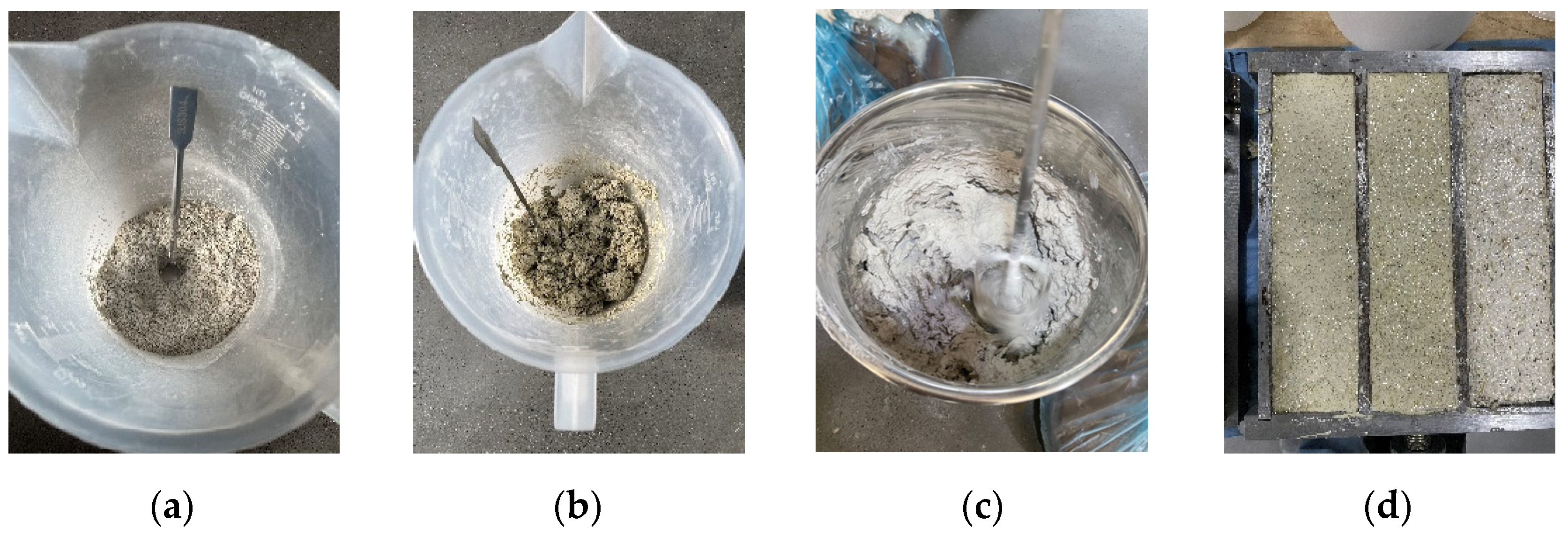
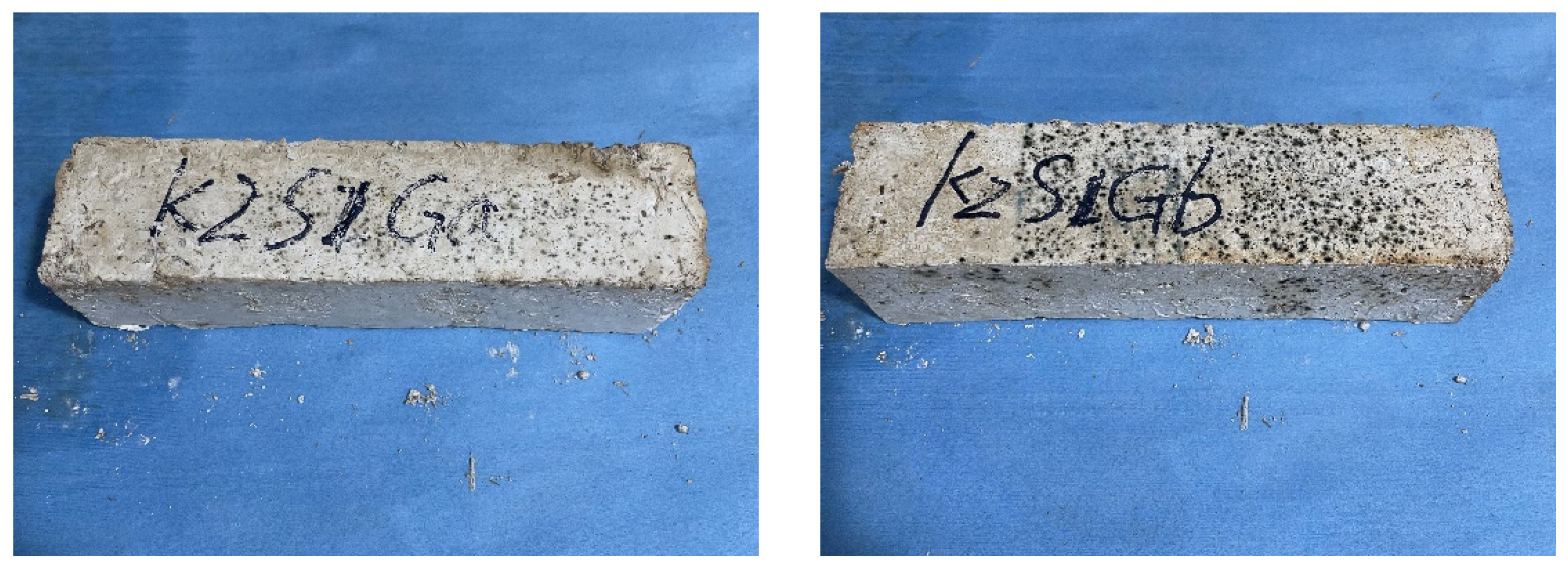

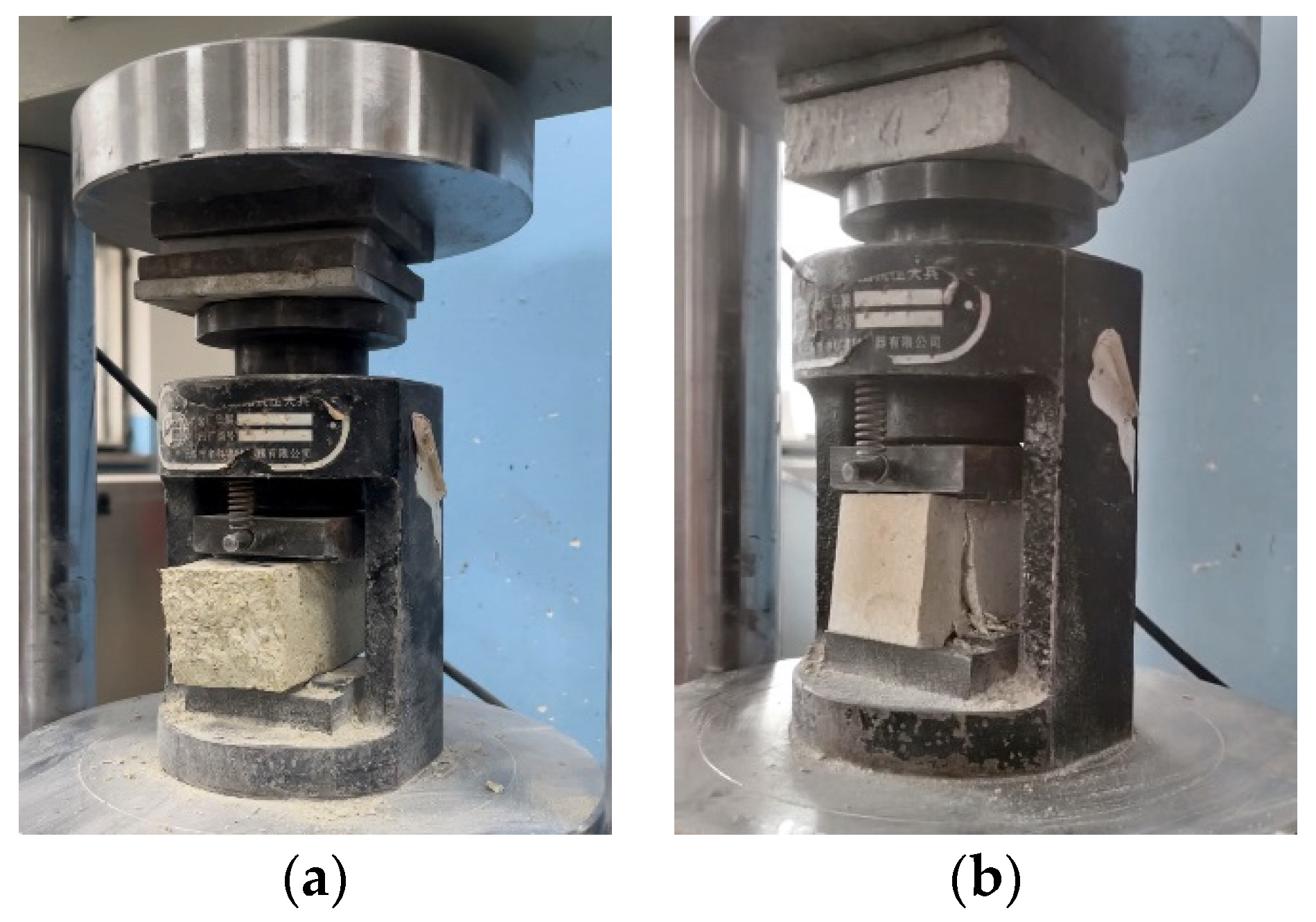



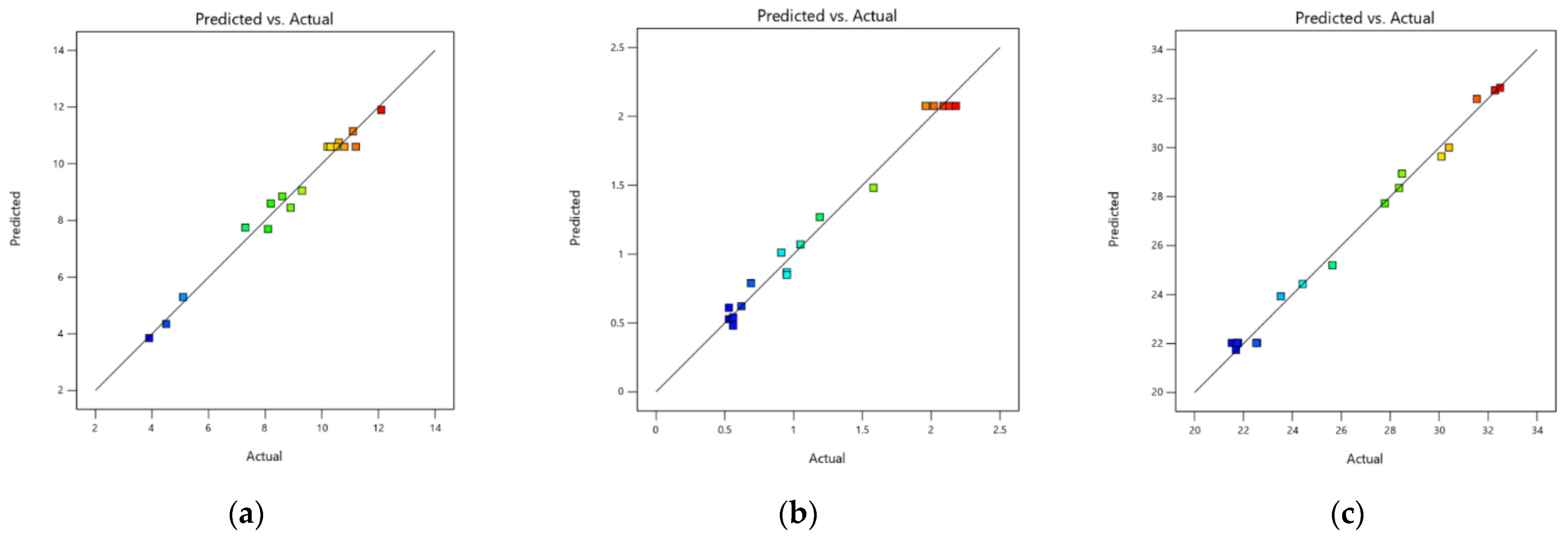
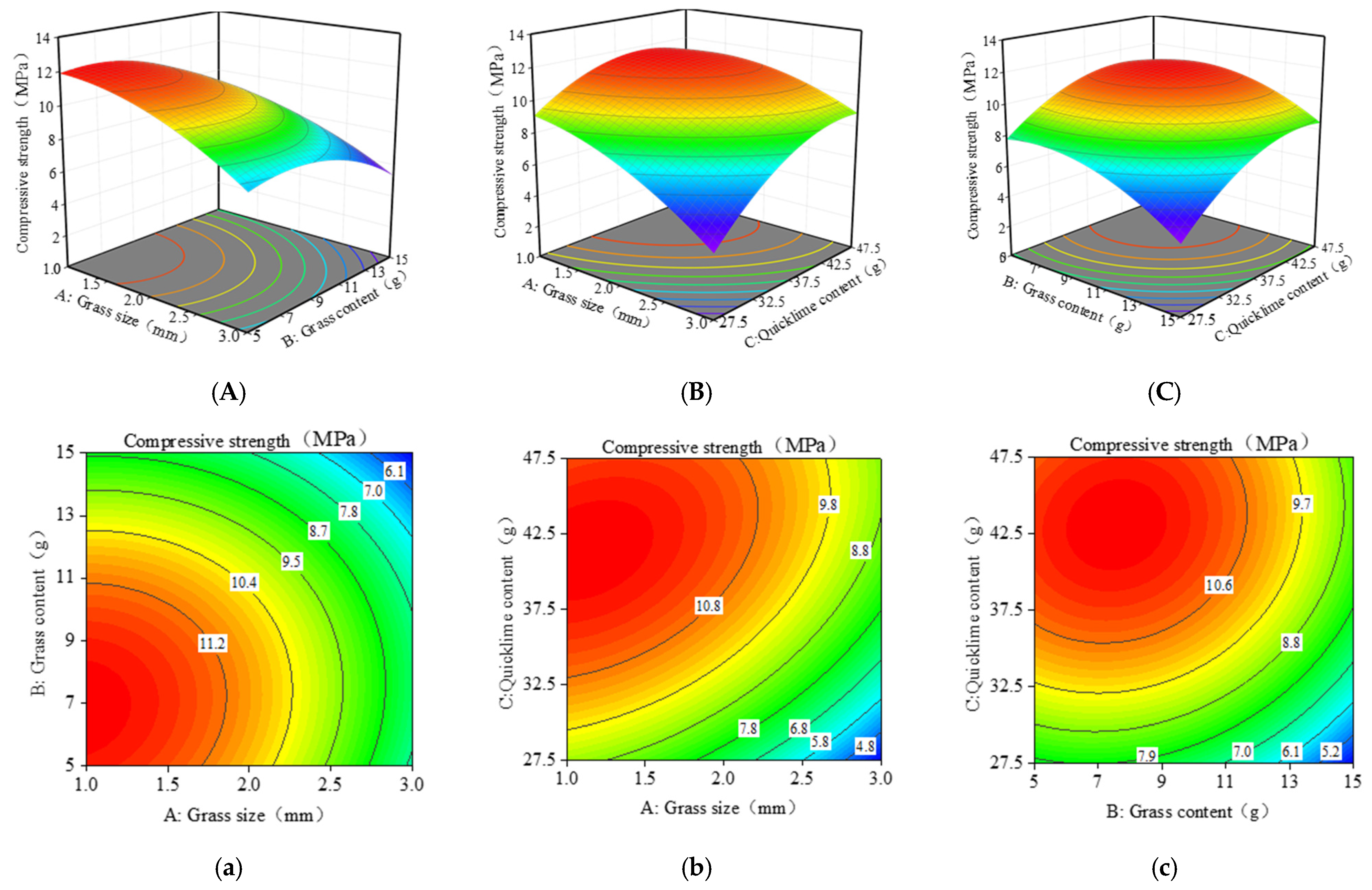

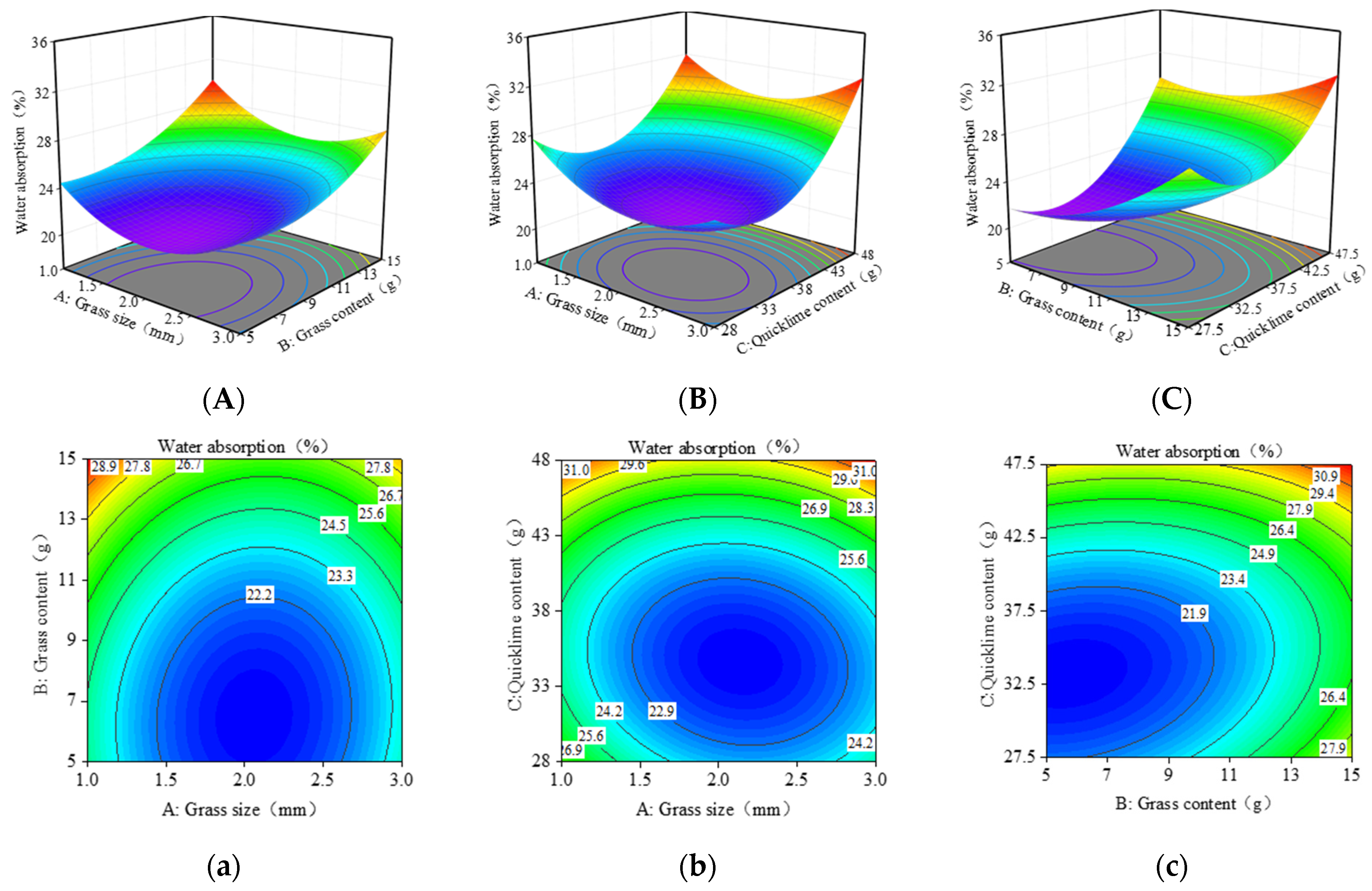
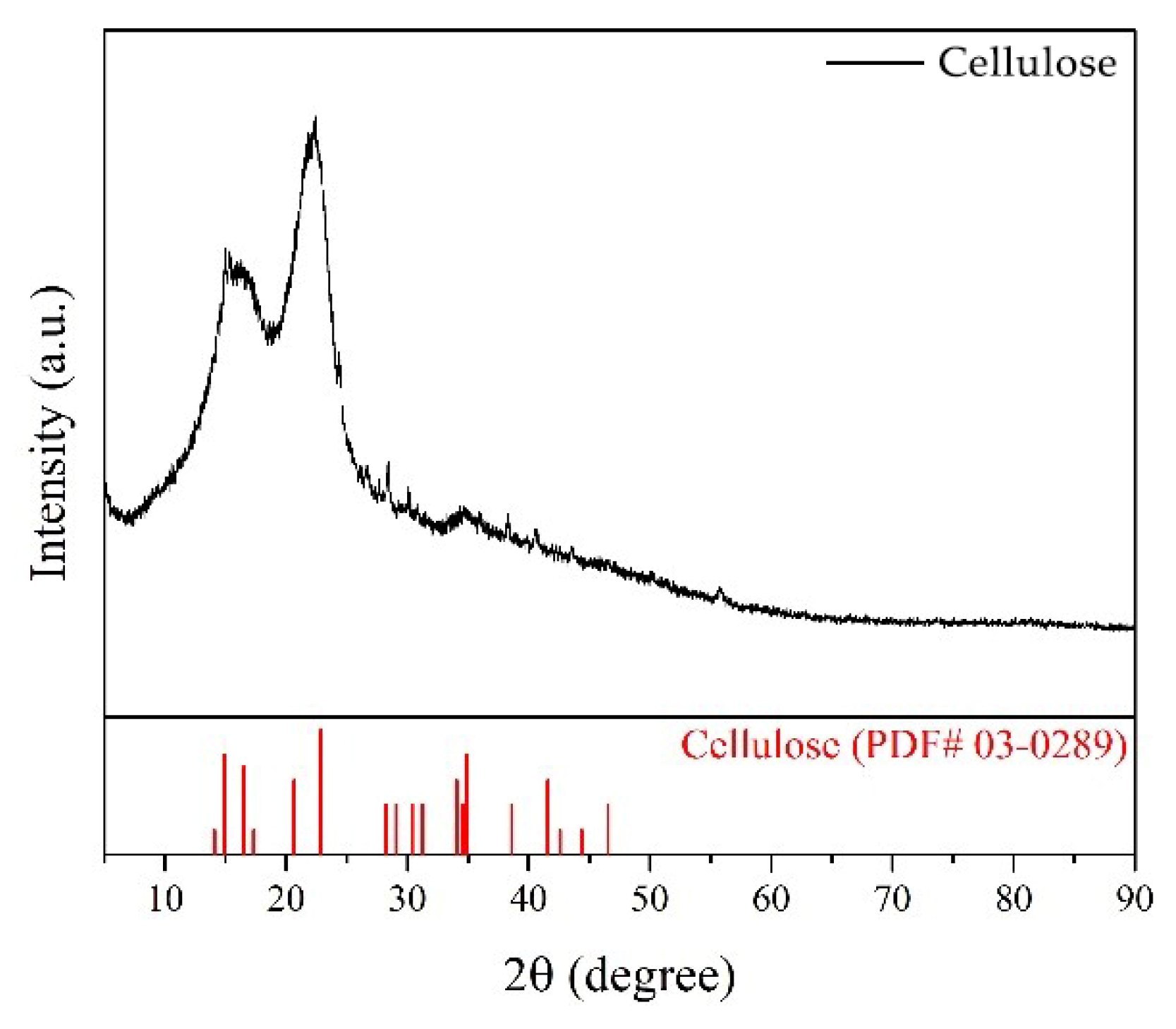

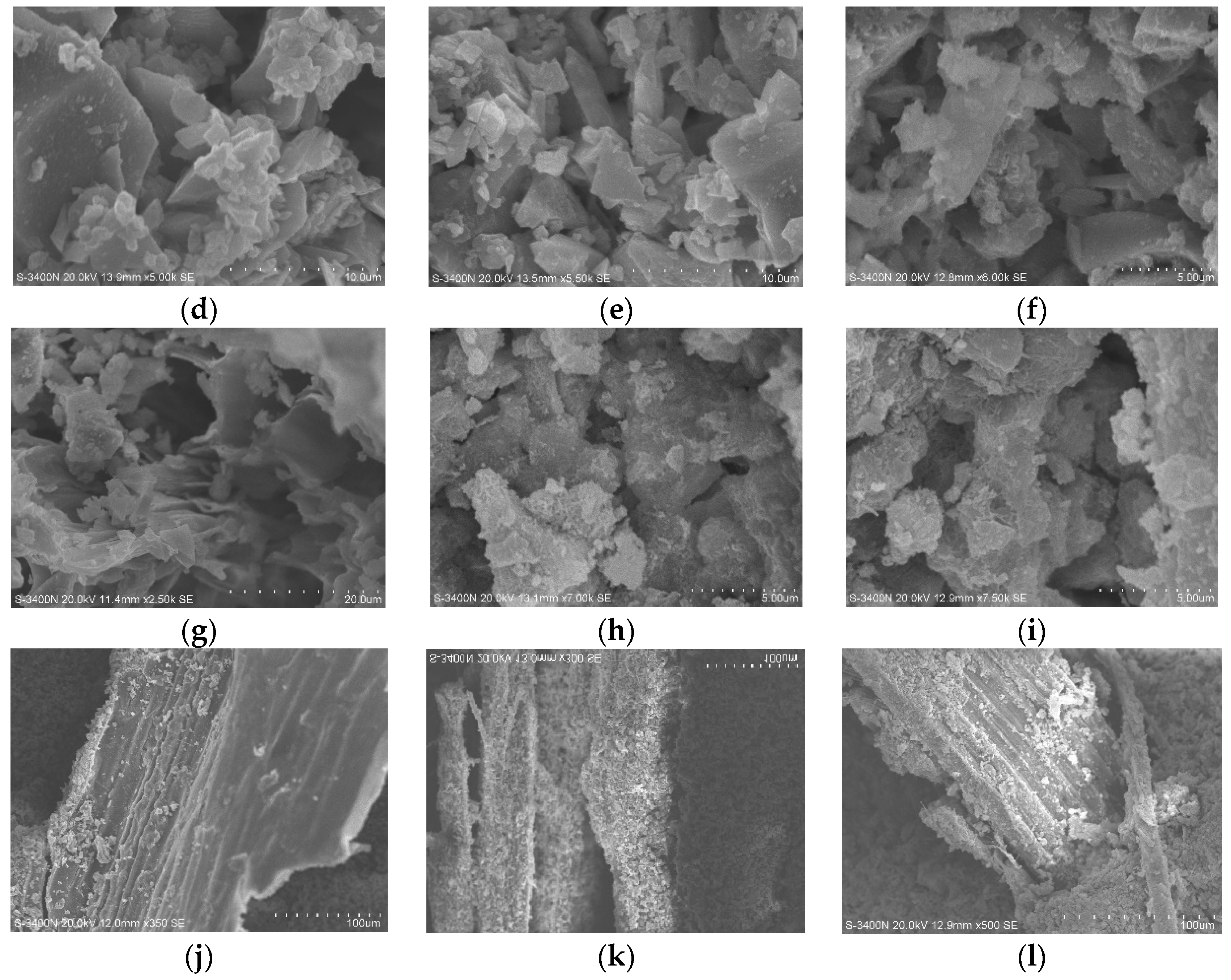
| Form | CaO | SiO2 | Al2O3 | MgO | Fe2O3 | SO3 |
|---|---|---|---|---|---|---|
| S105 slag | 35.30 | 34.50 | 16.70 | 5.01 | 1.50 | 1.24 |
| Specific Surface Area (m2/kg) | Flowability Ratio (%) | Activity Index 7d (%) | Activity Index 28d (%) | Density (g/cm3) | Loss on Ignition (%) | Water Content (%) |
|---|---|---|---|---|---|---|
| 628.00 | 102.00 | 98.00 | 115.00 | 2.93 | 0.96 | 0.20 |
| Factor | Level | ||
|---|---|---|---|
| −1 | 0 | 1 | |
| A—Grass size (mm) | 1 | 2 | 3 |
| B—Grass content (g) | 5 | 10 | 15 |
| C—Quicklime content (g) | 27.5 | 37.5 | 47.5 |
| Test No. | A—Grass Size (mm) | B—Grass Content (g) | C—Quicklime Content (g) | Y1—Compressive Strength (MPa) | Y2—Flexural Strength (%) | Y3—Water Absorption Rate (%) |
|---|---|---|---|---|---|---|
| 1 | 1 | 5 | 37.5 | 12.1 | 0.53 | 24.42 |
| 2 | 3 | 5 | 37.5 | 8.1 | 1.58 | 23.53 |
| 3 | 1 | 15 | 37.5 | 8.2 | 0.69 | 30.4 |
| 4 | 3 | 15 | 37.5 | 5.1 | 0.95 | 28.36 |
| 5 | 1 | 10 | 27.5 | 9.3 | 0.56 | 27.78 |
| 6 | 3 | 10 | 27.5 | 3.9 | 0.91 | 25.64 |
| 7 | 1 | 10 | 47.5 | 11.1 | 0.95 | 31.54 |
| 8 | 3 | 10 | 47.5 | 8.6 | 1.19 | 32.28 |
| 9 | 2 | 5 | 27.5 | 7.3 | 0.53 | 21.69 |
| 10 | 2 | 15 | 27.5 | 4.5 | 0.56 | 28.48 |
| 11 | 2 | 5 | 47.5 | 10.6 | 1.05 | 30.09 |
| 12 | 2 | 15 | 47.5 | 8.9 | 0.62 | 32.49 |
| 13 | 2 | 10 | 37.5 | 10.5 | 2.09 | 21.52 |
| 14 | 2 | 10 | 37.5 | 10.2 | 2.02 | 21.78 |
| 15 | 2 | 10 | 37.5 | 10.3 | 1.96 | 22.56 |
| 16 | 2 | 10 | 37.5 | 11.2 | 2.13 | 21.74 |
| 17 | 2 | 10 | 37.5 | 10.8 | 2.18 | 22.52 |
| Sources | The Sum of Squared Deviations | Degrees of Freedom | Mean Square | F-Values | p-Values Prob > F | Significant |
|---|---|---|---|---|---|---|
| Models | 94.16 | 9 | 10.46 | 44.66 | <0.0001 | ** |
| A—Grass size | 28.12 | 1 | 28.12 | 120.05 | <0.0001 | ** |
| B—Grass content | 16.24 | 1 | 16.24 | 69.34 | <0.0001 | ** |
| C—Quicklime content | 25.2 | 1 | 25.2 | 107.58 | <0.0001 | ** |
| AB | 0.2 | 1 | 0.2 | 0.86 | 0.3835 | |
| AC | 2.1 | 1 | 2.1 | 8.97 | 0.0201 | * |
| BC | 0.3 | 1 | 0.3 | 1.29 | 0.2932 | |
| A2 | 3.51 | 1 | 3.51 | 14.96 | 0.0061 | ** |
| B2 | 7.25 | 1 | 7.25 | 30.96 | 0.0008 | ** |
| C2 | 9.01 | 1 | 9.01 | 38.44 | 0.0004 | ** |
| Residual | 1.64 | 7 | 0.23 | |||
| Lost proposal | 0.98 | 3 | 0.33 | 1.98 | 0.2592 | ns |
| Pure error | 0.66 | 4 | 0.16 | |||
| Aggregate | 95.8 | 16 |
| Sources | The Sum of Squared Deviations | Degrees of Freedom | Mean Square | F-Values | p-Values Prob > F | Significant |
|---|---|---|---|---|---|---|
| Models | 6.46 | 9 | 0.72 | 51.82 | <0.0001 | ** |
| A—Grass size | 0.45 | 1 | 0.45 | 32.58 | 0.0007 | ** |
| B—Grass content | 0.095 | 1 | 0.095 | 6.83 | 0.0347 | * |
| C—Quicklime content | 0.2 | 1 | 0.2 | 14.1 | 0.0071 | ** |
| AB | 0.16 | 1 | 0.16 | 11.27 | 0.0121 | * |
| AC | 3.03 × 10−3 | 1 | 3.03 × 10−3 | 0.22 | 0.6544 | |
| BC | 0.053 | 1 | 0.053 | 3.82 | 0.0916 | |
| A2 | 0.9 | 1 | 0.9 | 65.17 | <0.0001 | ** |
| B2 | 1.92 | 1 | 1.92 | 138.73 | <0.0001 | * |
| C2 | 2.13 | 1 | 2.13 | 153.47 | <0.0001 | ** |
| Residual | 0.097 | 7 | 0.014 | |||
| Lost proposal | 0.066 | 3 | 0.022 | 2.9 | 0.1650 | ns |
| Pure error | 0.031 | 4 | 7.63 × 10−3 | |||
| Aggregate | 6.56 | 16 |
| Sources | The Sum of Squared Deviations | Degrees of Freedom | Mean Square | F-Values | p-Values Prob > F | Significant |
|---|---|---|---|---|---|---|
| Models | 267.08 | 9 | 29.68 | 101.17 | <0.0001 | ** |
| A—Grass size | 2.34 | 1 | 2.34 | 7.99 | 0.0255 | * |
| B—Grass content | 50 | 1 | 50 | 170.47 | <0.0001 | ** |
| C—Quicklime content | 65.04 | 1 | 65.04 | 221.73 | <0.0001 | ** |
| AB | 0.33 | 1 | 0.33 | 1.13 | 0.3236 | |
| AC | 2.07 | 1 | 2.07 | 7.07 | 0.0325 | * |
| BC | 4.82 | 1 | 4.82 | 16.43 | 0.0049 | ** |
| A2 | 35.12 | 1 | 35.12 | 119.73 | <0.0001 | ** |
| B2 | 13.12 | 1 | 13.12 | 44.74 | 0.0003 | ** |
| C2 | 81.44 | 1 | 81.44 | 277.66 | <0.0001 | ** |
| Residual | 2.05 | 7 | 0.29 | |||
| Lost proposal | 1.13 | 3 | 0.38 | 1.62 | 0.319 | ns |
| Pure error | 0.93 | 4 | 0.23 | |||
| Aggregate | 269.13 | 16 |
| Names | Units | Goals | Target | Level of Importance |
|---|---|---|---|---|
| A: grass size | mm | In range (1~3) | 2 | |
| B: grass content | g | In range (5~15) | 8.4 | |
| C: quicklime content | g | In range (27.5~47.5) | 38 | |
| Compressive strength | MPa | Maximize | 11.019 | 1 |
| Flexural strength | MPa | Maximize | 2.042 | 1 |
| Water absorption | % | Minimize | 21.538 | 1 |
Disclaimer/Publisher’s Note: The statements, opinions and data contained in all publications are solely those of the individual author(s) and contributor(s) and not of MDPI and/or the editor(s). MDPI and/or the editor(s) disclaim responsibility for any injury to people or property resulting from any ideas, methods, instructions or products referred to in the content. |
© 2024 by the authors. Licensee MDPI, Basel, Switzerland. This article is an open access article distributed under the terms and conditions of the Creative Commons Attribution (CC BY) license (https://creativecommons.org/licenses/by/4.0/).
Share and Cite
Ma, J.; He, L.; Wu, Z.; Hou, J. Optimization and Modelling of the Physical and Mechanical Properties of Grass Fiber Reinforced with Slag-Based Composites Using Response Surface Methodology. Materials 2024, 17, 3703. https://doi.org/10.3390/ma17153703
Ma J, He L, Wu Z, Hou J. Optimization and Modelling of the Physical and Mechanical Properties of Grass Fiber Reinforced with Slag-Based Composites Using Response Surface Methodology. Materials. 2024; 17(15):3703. https://doi.org/10.3390/ma17153703
Chicago/Turabian StyleMa, Jiale, Long He, Zhixin Wu, and Jiarui Hou. 2024. "Optimization and Modelling of the Physical and Mechanical Properties of Grass Fiber Reinforced with Slag-Based Composites Using Response Surface Methodology" Materials 17, no. 15: 3703. https://doi.org/10.3390/ma17153703





